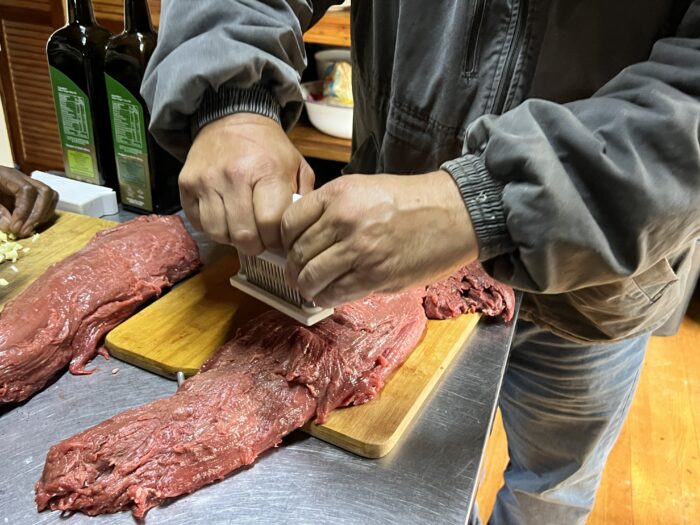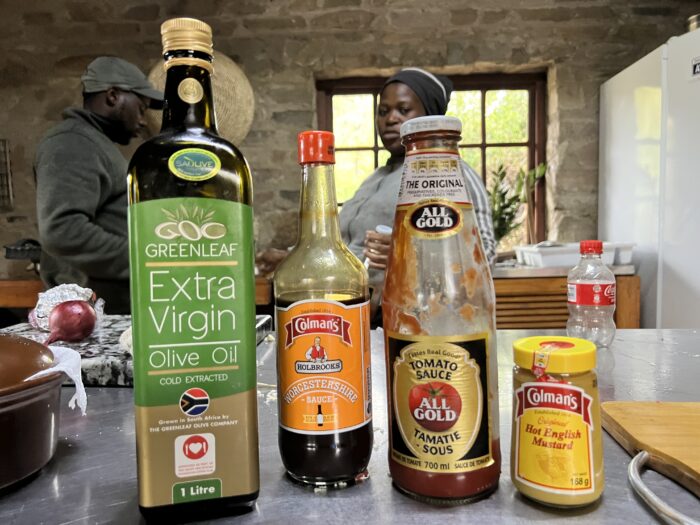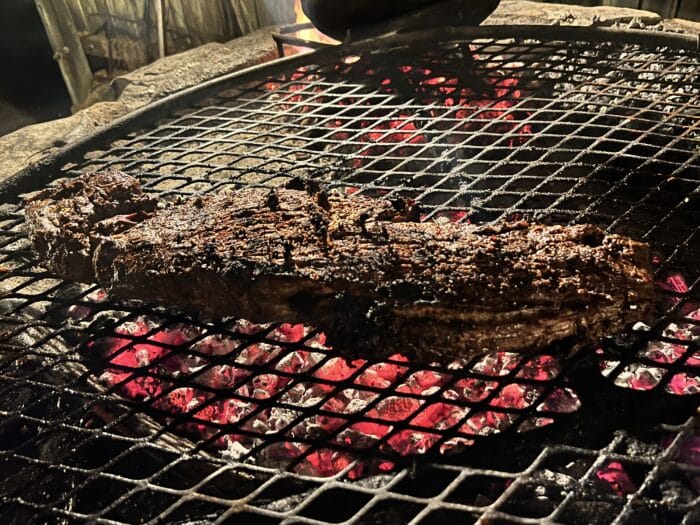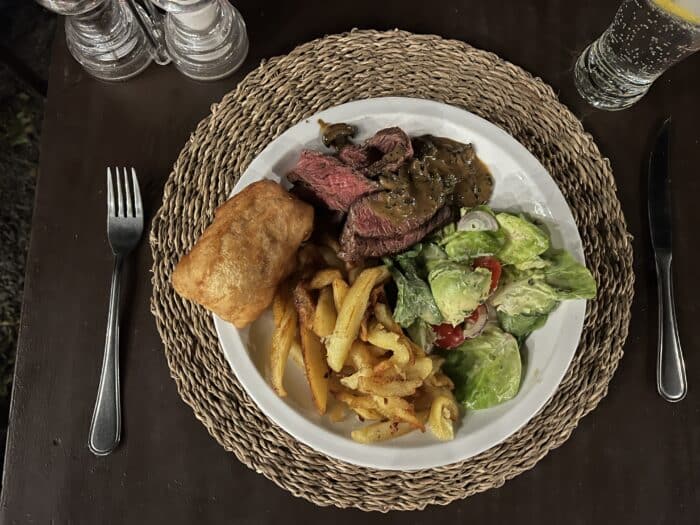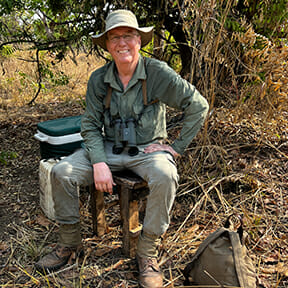The best meat in Africa from an old, rutting, eland bull?
It took only two hours, from the sound of the slap from the 200-grain Hornady ELDx fired from the Blaser R8 Ultimate resounding off the South African, Eastern Cape hillsides to the huge, Cape Eland bull disappearing down the brushy track in the embrace of an equally large front-end loader (a.k.a. ‘voorlaaier’ in Afrikaans). We were in the Kat River drainage, hunting with Stormberg Elangeni Safaris, on a gorgeous, game rich, 170,000-acre property made up of multiple farms cobbled together, with only low barbed wire fencing to keep cattle in the correct pastures. Hosted by Murray Danckwerts and guided by James Quin, my wife Frances and I quickly realized the quality and quantity of game, and Murray and his family adopted us into their clan. As we say in the southern US, we were in high cotton.
Though not intending to hunt an eland, I could not pass up the chance of taking such a magnificent trophy. And the adventure would not end with the recovery of the ~2000-pound bull. In fact, my next encounter with this animal would be in the form of spectacular, grilled loins the diameter of the downspouts on my home back in Georgia. When I contemplated the upcoming meal, I wondered how good the meat might be. Like a Rocky Mountain elk, herd bull, this animal was the dominant male, with females, likely in heat, and his testosterone likely at highest levels. He was also old, with scars from thorns and battles with other bulls, and wearing a magnificent ginger-colored ruff, called a kuif in Afrikaans, on his forehead. In other words, he should, by all rights, be as tough as shoe leather, and with a taste like the urine smeared into his ginger forehead.
Two hours later, standing in the kitchen just off the firepit/BBQ area, I checked out the marinade ingredients for the eland loins. With the loins’ enormous size, most of the contents of several bottles went into the large, stainless steel mixing bowl that would act as the container for the marinading meat. The ingredients included: South African-produced Extra Virgin Olive Oil, All Gold Tomato Sauce (what American’s refer to as Ketchup), Hot English Mustard and Worcestershire Sauce.
Before the marinade + eland loins made their way into the metal bowl, where they would sit for several hours on top of the refrigerator (it was nice and cold in the Eastern Cape in June), the staff brought out what looked like a tool for enhanced interrogation. Spring loaded, with three rows of 16, pointed, stainless steel rods, tenderizing the meat simply required resting the torture tool on top of the loin and compressing the springs. Sixteen neat holes appeared with each push. The ironic thing was that, as the chef stated, “this meat is tender already!” But the holes along the length of both loins allowed more effective marination, and though not needed for tenderizing, played an important role in the end product.
The next stage came as the staff, James, Murray and Murray’s sons started the same process people have enjoyed since we discovered fire, laying logs carefully and precisely to allow the hottest flames giving a bed of coals producing the perfect heat for grilling the eland loins. While the flaming logs shook themselves into a bed of coals, the various staff chefs (the cuisine was way too good to call them cooks) prepared salad, hand cut fried potatoes and bread, along with the gravy from the eland marinade. The smells increased our appetites from a sedate trot into a frantic gallop.
With coals now forming an even red-orange layer, the eland loins went on, sizzling immediately, their smoke smelling like the wonderfully aromatic marinade; it was still a question of whether the meat would taste as good as the marinade smoke smelled. Frances, a non-hunter, yet always willing to try new game meats, looked at me hopefully. I responded with raised eyebrows and a slight shrug. My unspoken thought: “At least the salad, bread and potatoes were a pretty sure bet.”
Even with them being the diameter of a firetruck hose, grilling the loins to medium required less than 10 minutes over the coals. The process of slicing them into serving-sized pieces took even less time. With plates heaped, we all gathered around the firepit, our chair seats placed over a coal-filled container to ward off the Eastern Cape Winter chill. I jokingly referred to the container as a bed-warmer for our backsides, however, it was a well appreciated extra indicating the thoughtfulness of Stormberg Elangeni Safaris and Murray et al. The time had finally arrived where we would discover whether age, hormones and the tension of the rut would trump any decent flavor from the eland loins.
I know you’ve already guessed that this article would not exist if the eland tasted like roadkill. We’ve eaten various cuts of eland since, and they have all been wonderful; this first eland eating experience was transformational. I have never tasted better meat, and I love ribeye steaks. I would gladly empty out my freezer of all other meat and fill it, and however many more freezers it took to hold the mass of meat from these giants, with cuts of eland.
I cannot wait to be in the next camp where a chef cooks up eland for dinner. In fact, I think I’d now be willing to try boiled eland hooves; ok, maybe not but hopefully the hyperbole communicates the feeling. To paraphrase the naturalist-explorer, William John Burchell, when eland is on the menu, the chef and host can expect me to be careful not to be absent at dinner time.
Mike Arnold has been a life-long hunter. The Hunter’s Horn blew very early for him. From the age of five, Mike has spent months each year pursuing game animals – from quail and rabbits behind his parents’ house, to kudu and leopard in Africa, and Brocket deer in Mexico. Mike’s articles include feature pieces in Sports Afield, Hunter’s Horn, Safari Magazine, and African Hunting Gazette. Mike also produced two TEDx presentations on the topic of conservation-through-trophy-hunting. You can find links to many of his articles and his Blog here.
Mike is also a Professor and the Head of the Department of Genetics at the University of Georgia. He works in conservation biology and is the author of the 2022 book, BRINGING BACK THE LIONS: International Hunters, Local Tribespeople, and the Miraculous Rescue of a Doomed Ecosystem in Mozambique. Mike’s book is available for purchase at bringingbackthelions.com, Amazon and local bookstores.


